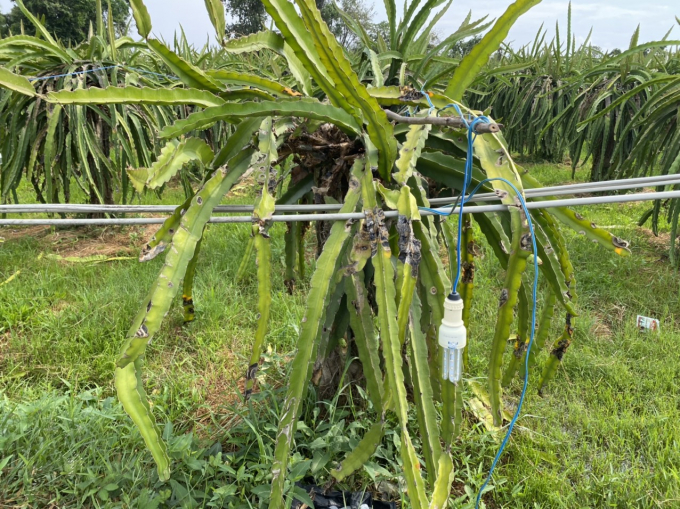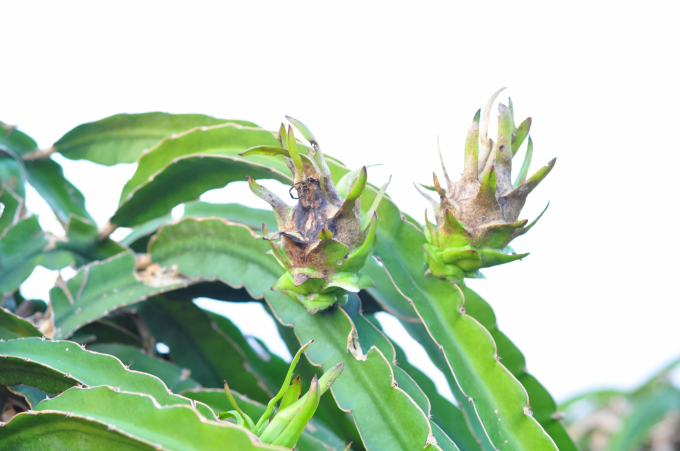Dragon fruit is one of the fruit trees with high export value, grown in provinces of Binh Thuan, Long An, and Tien Giang. However, in recent years, epidemics, especially BSD have reduced yield and product quality. This disease is caused by the fungus Neoscytalidium dimidiatum belonging to the Botryosphaeriaceae family, Botryosphaeriales order, and Ascomycetes class.

(Symptoms of brown spot disease on dragon fruit leaves. Photo: TL)
Using chemical pesticides based on Azoxystrobin and Sifenoconazole can effectively control the disease. But chemical residue in the fruit will hinder exports to fastidious markets such as the EU, US, and Japan.
Coping with this problem, the IAE has studied the use of microorganisms as biological agents to control BSD on dragon fruit. This is an active research direction, meeting the quality and safety requirements for export and domestic consumption as well as contributing to limiting the use of chemicals in agricultural production.
To determine the microorganism density, the IAE focuses on agar plate researching methods to calculate the number of microorganisms per ml or per gram of sample through the number of growing colonies in the environmental plate.
Based on the determination of biological activity (ability to inhibit fungi) of microbial strains by diffusion ring measuring method on agar, the Environmental Biology Faculty under IAE used molecular biology technique to sequence 16s ribosomal RNA gene segments of researched microorganisms.

(BSD on dragon fruit is a very difficult disease to prevent, so biological solutions are very important to control it. Photo: NNVN.)
At the same time, the research team compared with the sequences available in the international gene bank EMBL by FASTA 33 method to identify the species of microorganisms.
After comparing with the European Community's list of safe microorganisms, the research team had identified and ensured the safety of the selected microorganism strain.
With soil samples taken from gardens with infected dragon fruit in Binh Thuan, Long An, and Tien Giang, the IAE scientists isolated and selected 10 strains of microorganisms that have inhibitory capacity against the fungus Neoscytalidium dimidiatum, of which 7 strains belong to bacteria group and 3 strains belong to actinomycete group.
The results of biological activity evaluation by diffusion method on agar plates showed that the control formulas (using sterilized distilled water) did not appear the fungus Neoscytalidium dimitiatum inhibition ring.
Specifically, strain A1 had a low inhibitory ability of Neoscytalidium dimitiatum (inhibitory ring diameter = 13.0mm). Trains A3 and B7 had the highest inhibitory ring diameter (21.0±3 and 23.0±3 mm respectively) and were selected by the research team to be used as materials.

Images of Neoscytalidium dimitiatum antagonistic rings (top image) and strain colony (bottom image) of B7, A3. Photo: VMTNN.
According to the Agricultural Biology Faculty, colony B7 raised on KB medium has round shape, serrated edge, and milky white color. Shaken culturing on a liquid medium after 48 hours, the highest cell density reached 7,109 CFU/ml.
The 16S rRNA gene sequence of strain B7 is 100% homologous (1414/1414 bp) with the 16S fragment of Bacillus polyfermenticus; 99.9% homology (1413/1414 bp) with 16S fragment of Bacillus axarquiensis, Brevibacterium halotolerans. Based on the results of gene sequencing and biochemical characteristics of the studied bacteria, strain B7 has similar characteristics to the strain of bacteria named Bacillus polyfermenticus.
Meanwhile, colony A3 grown on Gauze medium are round, 2.2-2.5mm in diameter, pinkish in color, and the colony feet stick deeply in the medium. Shaken culturing on liquid medium, after 72 hours forming small particles about 1mm in size, made on culture medium and on the wall of the flask formed a white scum ring, tightly adhered to the wall of the flask with the cell density reaching 2,109 CFU/ml.
The 16S ARNr sequence of strain A3 is 100% homologous (1500/1500 bp) with the 16S DNAr fragment of Streptomyces fradiae and Streptomyces rubrolavendulae; 99.8% (1497/1500 bp) with Streptomyces roseoflavus. Based on the results of gene sequencing and biochemical characteristics of the researched actinomycetes, strain A3 has similar characteristics to the actinomycete named Streptomyces fradiae.

Regarding biosafety, according to European Community’s Directive 90/679/EWG, biological agents are classified into 4 safety levels, in which only microorganisms at levels 1 and 2 are used in production under normal conditions. Biosecurity levels 1 - 4 are general biosecurity levels, mainly for biological agents such as bacteria, viruses, fungi and parasites (both with and without genetic modification).
Thus, the research results show that Bacillus polyfermenticus and Streptomyces fradiae are classified as microorganisms with biosafety level 2, which can be widely used in the production of antagonistic fungus Neoscytalidium dimittiatum. Products applying methods of resistance to BSD on dragon fruit are eligible for exports to Europe.
(https://vietnamagriculture.nongnghiep.vn/treatment-of-bsd-on-dragon-fruit-ensures-european-export-standards-d312126.html)